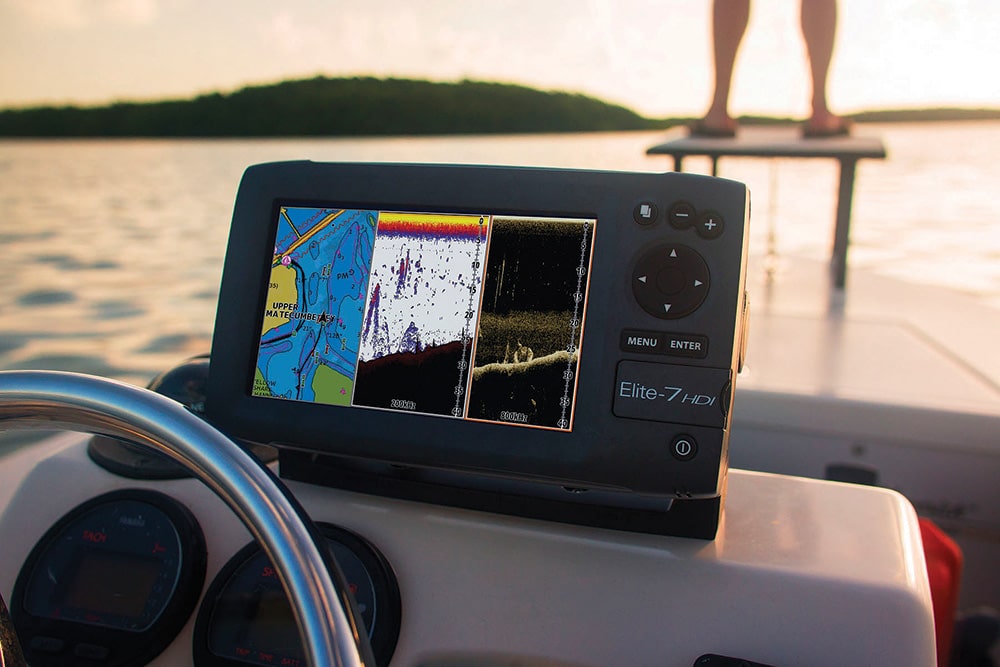Click through the images above to see units by a number of manufacturers.
In the current arena of integrated and networked marine electronics, a place still exists for stand-alone instruments. Maybe you need a big, dedicated sonar, so a reliable fish finder is a constant; maybe you want to be sure that after a long run to the canyons, or the deep Gulf, if something goes on the blink, you can keep fishing. Or maybe you run a bay boat or skiff, and depth is seldom a concern, but you need a plotter, a set of electronic charts sitting atop your console. Stand-alones are in demand for several reasons, and manufacturers continue to provide anglers what they need.
Most traditional perhaps is a dedicated fish finder augmenting a networked helm. Recognizing this option, Furuno has rolled out two new stand-alones, the 5.7-inch FCV627 ($995) and the 8.4-inch FCV587 ($1,695). “These finders are a great fit on center consoles,” says Furuno’s Jeff Kauzlaric. “But we’ve
put them on everything from 20-foot trailer boats to the 50-footers, as both backups and primary sounders.”
Fishermen have preferences and budgets, he says. “If they are going to fit something in a budget and can’t afford all Furuno, they go with a less expensive chart plotter and a Furuno fish finder. There are still people out there who want to have separate units or who want to mix and match manufacturers.”
Si-Tex Marine Electronics has built a loyal following on stand-alones. “We are one of the few companies that still has dedicated stand-alone products,” says Si-Tex vice president Allen Schneider. The success of the stand-alones, he says, is based on redundancy, simplicity and economy. “The first advantage of stand-alones is the simplicity of setting it up and forgetting it. The second benefit is redundancy. With a stand-alone, if one display goes out, you have lost only a portion of the data you need. On a network-based MFD system, if the display goes out, you have lost everything.”
Another consideration is upgrading particular elements of the system, which is simplified with single-purpose machines. “If new technology comes along and you want to upgrade one piece of your system, you do not have to scrap the entire package to take advantage of the technology — just replace that portion of the package,” says Schneider. Si-Tex’s newest introduction is the 7-inch SNS-700 plotter ($1,199), which comes loaded with C-Map Max cartography, and is also available with a built-in-sonar option.
Multifunction Stand-Alone
The majority of stand-alones combine the sounder and plotter on one machine. In this case, stand-alone means a dual-function instrument that’s not part of a network. This makes sense, as plotter and sounder functions increasingly overlap. Case in point is the functionality of Lowrance stand-alones, most recently the Elite-7, a combination unit sized for smaller boats, where a network is unnecessary.
Recording and saving bottom data is the hallmark of the Lowrance Insight Genesis mapping system that allows anglers to create custom charts based on sonar logs: a function that requires plotter and sonar to work together. The 7-inch Elite-7 is available as a plotter, fish finder or combo model ($499 to $869).
Garmin’s new 5-inch GPSMAP 547 plotter ($749.99), plotter/sonar 547XS ($849.99), 7-inch GPSMAP 741 plotter ($1,599.99) and combo GPSMAP 741XS ($1,699.99) are designed to fit fishing boats in the 18- to 21-foot range. Different mounting options accommodate just about any helm configuration, on any size boat. They can flush, flat or surface mount; the 500 series has a swivel mount available, and the larger 700 series has a gimbal mount. While not networkable, these are sophisticated instruments; the sonar versions are CHIRP capable for maximum detail and resolution. They are preloaded with coastal cartography, and upgradable to Garmin’s proprietary G2Vision cartography.
Max Options
Raymarine has moved away from nonnetwork sounders and plotters, according to marketing manager Jim McGowan. The company’s smallest and most economical rollout, the a65 GPS/chart plotter ($814.99) and a67 GPS/chart plotter/fish finder ($914.99) combine power, simplicity and economy.
“Out of the box you can run this as a plotter,” says McGowan. “There is one screen, one box, and even with the fish finder, it’s under $1,000.” The a-series is networkable, but it’s not necessary. “You can add a second screen on the other end of the boat, or a higher-powered sounder on the network. The adaptability is there,” says McGowan. Both GPS and sounder modules are built in, so the units are totally self-contained, perfect for fishing boats in the 20-foot-and-under range. Though diminutive, the a-series has the same processor, graphics and software as Raymarine’s larger systems. “Small doesn’t mean cheap in boats,” says McGowan. “There are a lot of premium small boats, and fishermen in that category demand the premium navigational experience the a-series provides.”














